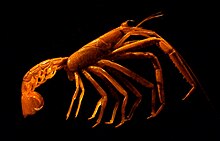| Glypheoidea Temporal range:
| |
|---|---|

| |
| Neoglyphea inopinata | |
| Scientific classification | |
| Domain: | Eukaryota |
| Kingdom: | Animalia |
| Phylum: | Arthropoda |
| Class: | Malacostraca |
| Order: | Decapoda |
| Suborder: | Pleocyemata |
| Infraorder: | Glypheidea |
| Superfamily: | Glypheoidea Winkler, 1883 |
The Glypheoidea (containing the glypheoid lobsters), is a group of lobster-like decapod crustaceans which forms an important part of fossil faunas, such as the Solnhofen limestone. These fossils included taxa such as Glyphea (from which the group takes its name), and Mecochirus, mostly with elongated (often semichelate) chelipeds. This group of decapods is a good example of a living fossil, or a lazarus taxon, since until their discovery in the 1970s, the group was considered to have become extinct in the Eocene. The superfamily Glypheoidea comprises five families. The two extant species, Neoglyphea inopinata and Laurentaeglyphea neocaledonica, are both in the family Glypheidae.